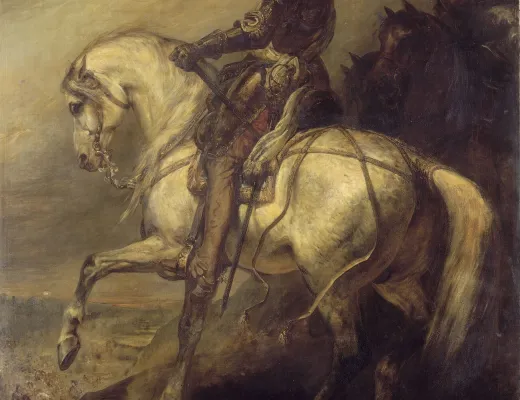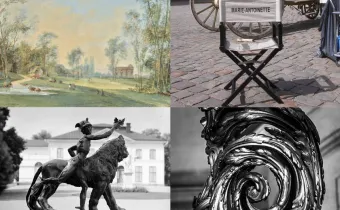Imperial Silks for Versailles, Mobilier national Collection
19 March to 23 June 2024
Grand Trianon
In partnership with the Mobilier national
In February 1810, Napoleon, who had expressed the desire to refurbish Versailles, granted a special fund of six million francs for this purpose. At the same time, Lyon silk manufacturers were facing great difficulties. The Emperor wished to place a large order to help them out of this crisis, allocating them two million francs. Between 1811 and 1813, no less than 80 kilometres (50 miles) of fabrics were delivered by the Lyon silk manufacturers to the Imperial Garde-Meuble for Versailles. This exhibition from the Palace of Versailles and the Mobilier national will look back on the history of this great commission.
The first part of the exhibition will evoke the historical and economic context of this exceptional order. Original samples and archival documents will illustrate the involvement of various stakeholders, from the Lyon silk manufacturers to the meticulous imperial administration, which developed unprecedented verification techniques for this order. Moreover, progress in the textile field will be discussed through the presentation of a Jacquard mechanical loom and investigation techniques in chemistry and dyeing.
The second part will be dedicated to the architectural renovations Napoleon had planned for Versailles, forming the context of the order placed with the Lyon silk manufacturers. Architectural debates and the changing tastes between the Ancien Régime and the early 19th century will be highlighted, notably through drawings by Jacques Gondoin.
The exhibition will then present the various Lyon silk manufacturers’ decor projects for Versailles and what happened to the silks from Napoleon’s great order, particularly under the July Monarchy and the Second Empire. The 80 kilometres of fabric delivered in 1813 – unused under the First Empire – reflect the unexpected originality of the colours and patterns chosen. The Lyon silk manufacturers, revitalised by this impressive order, competed in daring to please the Emperor and his wife. The exhibition will also present a unique collection of 120 silks.
With a wide variety of silk samples in terms of colours and patterns, the exhibition will explore the world of the Lyon manufacturers under the First Empire.
Finally, the tour of the Emperor’s apartment at the Grand Trianon will be included in the exhibition’s itinerary on an exceptional basis. Samples of the original Lyon fabrics will be compared with textile restorations.
Curators
Muriel Barbier, Heritage Curator
Noémie Wansart, Scientific Collaborator, National Museum of the Palaces of Versailles and Trianon
Eva Jospin - Versailles
18 June to 29 September 2024
Orangery of the Palace of Versailles
Inspired by the Embroidery Room of the Palazzo Colonna in Rome and Virginia Woolf’s A Room of One’s Own, Silk Room represents a feat of embroidery. Its 350 m2 (3,767 sq. ft.) landscape-depicting walls were produced by the craftsmen of the Chanakya workshop and the Chanakya School of Craft in Mumbai in constant dialogue with Eva Jospin. Each stroke of the artist’s drawing was transfigured into thread through the use of more than 400 shades of silk, cotton, and jute skeins, creating an installation in the style of 19th-century panoramas. Invited by Maria Grazia Chiuri, Eva Jospin previously presented Silk Room at the Dior Fall-Winter 2020–2021 haute couture fashion show.
A unique dialogue with the Orangery of the Palace of Versailles
To create this striking piece, Eva Jospin drew from her usual themes of choice, namely nature, strolling, and architectural follies. Silk Room will be presented in the Orangery in a linear fashion, thus enticing visitors to wander and engage in an immersive experience.
Especially for this exhibition, Eva Jospin will be adding a new embroidery panel to her work. The panel takes inspiration from the groves of the gardens of Versailles, most particularly Apollo’s Baths Grove, which was redesigned at the end of the 18th century by the painter and landscape gardener Hubert Robert, whose work nourishes Eva Jospin’s reflection on the importance of gardens. The Orangery’s unique architectural strength sets it apart as the ideal setting for the artist’s monumental embroidery work while also resonating with it in terms of scale and the theme of strolling. A visit to Versailles already offers ample opportunity to stroll between groves and waterfalls. This embroidery work provides another, inviting visitors to take their time wandering, like a mise-en-abyme within its motifs. As if seen in a mirror, Jospin has succeeded in capturing a different garden, as spectacular as those at Versailles.
Eva Jospin
Born in 1975, Eva Jospin studied at the Ecole des Beaux-Arts in Paris. For fifteen years now, she has been composing forest and architectural landscapes in a variety of media. Recipient of the Académie des Beaux-Arts Award in 2015 and artist in residence at the Villa Medici in Rome in 2017, she has had numerous major exhibitions in Europe, America, and France, and is currently exposed at the Palais des Papes in Avignon with Palazzo. Eva Jospin has been represented by GALLERIA CONTINUA since May 2023.
This exhibition is made possible thanks to the patronage of Parfums Christian Dior
![]()
The horse in Majesty, at the heart of a civilisation
2 July to 3 November 2024
Palace of Versailles
The Palace of Versailles will present a special exhibition dedicated to horses and equestrian civilisation in Western culture from the 16th century to the early 20th century. Over 400 works from collections around the world, many of which will be exhibited for the first time in France, will shed light on the long shared history between man and horse. The trilogy of Service, Pleasure and Power govern the equestrian culture of modern times in Europe. Among the foremost means of expressing power and distinction, the horse will be considered in its multiple dimensions: political, military, academic, scientific, artistic, cultural, legendary, and imaginary. The exhibition will unfold through a journey across several of the Palace’s most iconic spaces.
Curators
Laurent Salomé, Director of the National Museum of the Palaces of Versailles and Trianon
Hélène Delalex, Heritage Curator of the National Museum of the Palaces of Versailles and Trianon
The Palace of Versailles and the Forbidden City, Exchanges between France and China in the 18th Century
1 April to 30 June 2024
Palace Museum, Forbidden City, Beijing
In partnership with the Palace Museum, Beijing
On the occasion of the sixtieth anniversary of diplomatic relations between France and China, the Palace of Versailles and the Forbidden City will present an exhibition dedicated to the exchanges established between the two countries since the end of the 17th century.
The exhibition will illustrate the diplomatic policy initiated by Louis XIV towards his contemporary, Emperor Kangxi, particularly marked by the sending of French Jesuit missionaries to China in 1685, who reached the court of Beijing as the King’s mathematicians. This initiative allowed the two countries to establish relations of often ignored mutual trust and esteem which lasted until the end of the 18th century. This particular diplomatic situation and mutual interest contributed to the birth of modern Sinology in France.
At the French court, a fascination with China and Chinese art was manifested in various ways, including four main phenomena: the importation of Chinese objets d’art, the transformation of certain imported works, the imitation of Chinese products, and the very lively influence of Chinese art in French art. The exhibition will thus illustrate the inexhaustible source of inspiration that various facets of Chinese art provided for French artists and intellectuals, whether in the field of painting, objets d’art, interior decor, architecture, garden art, literature, music, or the sciences.
At the same time, at the Chinese court, many French Jesuits followed the arrival of the King’s mathematicians sent by Louis XIV, some of whom served at the court for a long time. Through their presence, French culture had a significant influence in the fields of science, art, architecture, medicine, and cartography at the court of the Qing dynasty. Clocks, scientific instruments, prints, porcelain pieces, bronzes, books, and other objects from the Palace Museum’s collection attest to the cultural exchanges between the two countries.
The exhibition in Beijing will bring together a selection of works from the Palace of Versailles and the Palace Museum that will more broadly testify to the veritable fascination felt by the court of Versailles and by the great French lovers of China’s cultural exports. It reveals the efforts and achievements of China and France to achieve mutual understanding and cultural exchanges in the 18th century and vividly reconstitutes the cultural and artistic exchanges between the two countries.
Virtually Versailles
From 2 May 2024
Winland Center, Hangzhou, China
Following the success of its editions in Shanghai, Hong Kong, and Macao, the travelling exhibition Virtually Versailles will next visit the city of Hangzhou, China. This immersive exhibition will allow visitors from around the world to discover Versailles using the most innovative technologies, from augmented and virtual reality to connected bicycles and 360° projections.
Virtually Versailles is designed for first-time visitors to the palace, allowing a wide audience to discover its history and collections. However, each edition is unique and enhanced with new content and its own scenography.
In Hangzhou, the exhibition will be held at the Winland Center, at the heart of one of the city’s historic districts. On this occasion, 56 musicians from the Royal Opera Orchestra of Versailles will perform a concert at the opening of the exhibition.





